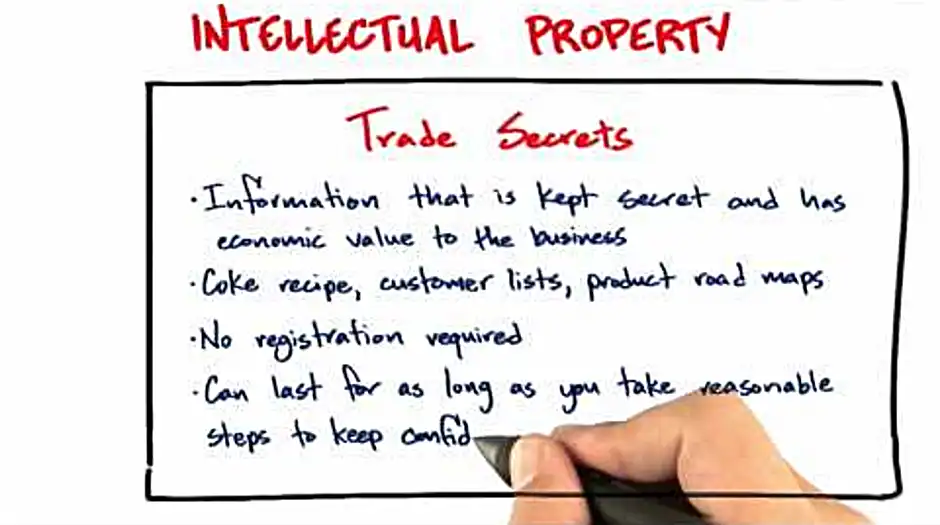Intellectual property for startups [FAQ]
Table of Contents
- What are the 4 types of intellectual property?
- Does my company own my ideas?
- How do I value an IP address at startup?
- How can I protect my idea?
- What is the difference between copyright and intellectual property?
- What are the 6 types of intellectual property?
- Is a trademark an intellectual property?
- Who owns intellectual property?
- What counts as intellectual property?
- How long does copyright last?
- How can I patent my idea for free?
- What are the 5 intellectual property?
- What are the 3 types of intellectual property?
- How do you set up intellectual property?
- What is a good example of intellectual property?
- What are the 7 intellectual property rights?
- How much does intellectual property cost?
- What is intellectual property in entrepreneurship?
- What is IPR in entrepreneurship?
- Does intellectual property have to be copyrighted?
Last updated : Sept 4, 2022
Written by : Cordie Honts |
Current |
Write a comment |
What are the 4 types of intellectual property?
Patents, trademarks, copyrights, and trade secrets are valuable assets of the company and understanding how they work and how they are created is critical to knowing how to protect them.
What are the 5 intellectual property?
In this post, we will explain the basics of the most common types of intellectual property — copyrights, moral rights, trademarks, patents, and trade secrets.
How do you set up intellectual property?
To obtain a patent in the U.S., the inventor must file a patent application with the United States Patent and Trademark Office (USPTO), which includes (1) a written document comprising a description and claims, (2) drawings when necessary, (3) an oath or declaration, and (4) filing, search, and examination fees.
What is a good example of intellectual property?
Utility patents: for tangible inventions, such as products, machines, devices, and composite materials, as well as new and useful processes. Design patents: the ornamental designs on manufactured products. Plant patents: new varieties of plants.
What are the 7 intellectual property rights?
Rights. Intellectual property rights include patents, copyright, industrial design rights, trademarks, plant variety rights, trade dress, geographical indications, and in some jurisdictions trade secrets.
How much does intellectual property cost?
Expect to pay anywhere between $3000 and $5000 on average plus the USPTO fees to an attorney to prepare a new patent application. The costs for the patent depends on the type of patent you apply for.
What is intellectual property in entrepreneurship?
Intellectual Property Definition: The ownership of ideas. Unlike tangible assets to your business such as computers or your office, intellectual property is a collection of ideas and concepts.
What is IPR in entrepreneurship?
Intellectual Property rights (IPR) allow innovative entrepreneurs to protect their inventions & new business ideas. IPR also helps the firms to recoup their innovation investment and consequently provides an incentive for investing in innovation.
Does intellectual property have to be copyrighted?
Copyright protects original works of authorship, while a patent protects inventions or discoveries. Ideas and discoveries are not protected by the copyright law, although the way in which they are expressed may be.
Does my company own my ideas?
Typically, employers are entitled to all intellectual property created at/for their business, unless there exists a contract stating otherwise.
How do I value an IP address at startup?
The value of the IP is the sum of the product of each value multiplied by its associated probability. The beauty of this approach is that it does not require revenue projections which are notoriously optimistic and generally wrong both in terms of timing and size.
How can I protect my idea?
First, you can file a provisional patent application (if your invention is patentable). Second, you can use a nondisclosure agreement (regardless of whether it is patentable). (Remember that inventors do not always need to license their invention in order to make money.
What is the difference between copyright and intellectual property?
Intellectual property (IP) is a term used to encompass a range of legal rights that protect the creations of the mind and creative effort. Patents, trademarks and registered designs are examples of IP, as is copyright. Copyright refers to the rights granted to the creators or copyright holders of original works.
What are the 6 types of intellectual property?
Intellectual property can exist as one of six major types: patents, trademarks, copyrights, design, databases, and trade secrets.
Is a trademark an intellectual property?
Trademarks, patents, and copyrights are different types of intellectual property. The USPTO grants patents and registers trademarks. The U.S. Copyright Office at the Library of Congress registers copyrights.
Who owns intellectual property?
Generally, the creator of a work is deemed its owner. However, intellectual property ownership can be determined differently for different types of property and under varying circumstances. For example, if work is created for an employer, the employer is the owner of that intellectual property.
What counts as intellectual property?
Intellectual property is traditionally comprised of four categories: patent, copyright, trademark, and trade secrets.
How long does copyright last?
As a general rule, for works created after January 1, 1978, copyright protection lasts for the life of the author plus an additional 70 years.
How can I patent my idea for free?
There are two ways you can actually patent an invention for free, sort of. If you cannot afford an agent or attorney, look to the Patent Pro Bono Program or the Law School Clinic Certification Program, both provided by the USPTO. The Patent Pro Bono Program pairs registered patent agents or attorneys with inventors.
What are the 3 types of intellectual property?
There are four main types of intellectual property rights, including patents, trademarks, copyrights, and trade secrets.

Check these related keywords for more interesting articles :
How to copyright a company name uk
How to calculate a patent bet
How to copyright a pen name
Difference between trademark and registered business name
Intellectual property work made for hire
Intellectual property act no 36 of 2003
Intellectual property management course
How to brand on social media
How to copyright and publish music
What are some examples of patent
How to brand your business on a budget
China trademark registration certificate
Intellectual property protection means
Intellectual property lawyer michigan
Trademark search nepal
Did you find this article relevant to what you were looking for?
Write a comment
Comment by Norbert Beagan
just to recap trademark protects branding and marks it gives you the right to prevent others from using confusingly similar mat marks and logos it lasts as long as you use the mark the more you use it the stronger your protection and there are country by country loss that kind of define trademark and it's optional to register it but it has significant advantages if it's approved copyright that just gives you the right to prevent others from copying or distributing or making derivatives of your work and you could copyright more than just technology it's what we do for songs books movies etc it lasts practically forever but doesn't prevent independent development someone else could do something independently and come up with something quite similar you could register it is optional but it's required to sue for infringement and sometimes you see copyright labelled on the bottom of something with a little C with a circle that means somebody is claiming that this is their original work and suggesting that you need their license or permission to make a copy trade secrets as we talked about you want to keep that secret and it has an economic value no registration is required it's basically how safe do you think your idea is going to be inside your company protected with armed guards and a vault it can last for as long as you take reasonable steps contracts again it's everything that's in the contract no registration process you have what her protection is defined in the contract now patents are interesting a patent is a government is giving you a monopoly by preventing others from making using or selling your invention even if the others infringement was innocent or accidental and this has to be a non-obvious invention it has to last other protection lasts for about fifteen to twenty years and there's a whole application and examination process and it's worth you getting up to date and understanding about patents early on very rough rule of thumb is if you're in web - oh you probably shouldn't be spending a lot of time on patents though there are exceptions if you're in life sciences and the other extreme you shouldn't leave your bedroom without a patent counsel walking you out there are some rules of thumb for each industry and each market and you really need to spend at least an hour before you director accompany understanding what rules apply
Thanks for your comment Norbert Beagan, have a nice day.
- Cordie Honts, Staff Member
Comment by smilindeeg
hello everyone i am jason tang a patent attorney with potter clarkson a european ip law firm we are pleased to be supporting the graphene hackathon team again and i thank them for inviting me to speak about iep and join the q a session after this talk ip is a very broad subject and today i will be focusing on how startups can develop an iep blueprint for growth in order to attract and secure funding a recent report from the scale-up institute innovate finance and deloitte identified a 14 billion pound funding gap for fast growth smes what does this mean for innovative startups who are looking to obtain investment in order to scale up in the face of the economic fallout from the pandemic innovation is vital being able to turn good ideas into a commercial success at scale can have a transformational impact on the wider economy however even the most groundbreaking of inventions requires investment to become a viable market proposition the road to securing funding is not always clear with various hurdles to overcome before winning the trust and backing of investors securing funding is fiercely competitive territory as investors apply a forensic approach to identifying the risk and opportunities with each investment target intellectual property alone will not likely secure funding but a weak ip position could significantly impact on valuation by as much as 70 in our experience or see an investor walk away altogether investors are looking for the most lucrative returns and if ever for the evidence were required to show how iep rights can underpin investment and support a strong return a new europe-wide study by the european patent office and the eu intellectual property office shows that smes with intellectual property rights generate 68 higher revenues per employee than those who don't i will go through the five key ingredients that will put a startup in the strongest ip position to attract and secure funding firstly establishing clear ownership failure to establish proper ownership of iep is the number one deal breaker any gray areas surrounding who owns iep will signal alarm bells for a potential investor innovation especially in starbucks can occur before commercial relationships and business processes have been formally defined which can make determining ip ownership less clear-cut where appropriate the necessary assignments should be signed and registered there should be clear and written agreements in place for any joint ventures or collaboration agreements establishing a process to be followed for determining ownership during collaborations is also important and can avoid difficult conversations after the event in more established smes commercial partnerships may have evolved over time but without formal agreements in place this is something that should be remedied immediately next effective innovation capture understanding what ip your business may have and what you might be able to protect is not always obvious it is always worth seeking professional advice early on to determine which iep rights you might be able to secure robust procedures play a big part in creating the right culture for effective innovation capture the first step will be to carry out an audit to evaluate your ip assets what is your iep have you come up with a new graphene application or a new manufacturing process does the innovation lie in a technical improvement such as better performance or higher efficiency however more often than it should be many innovations end up not being protected because they are mistakenly considered as not innovative enough a proper assessment of innovativeness must be carried out from both technical and legal perspectives after identifying your iep you then need to check your ipr do you have registered ip rights to protect your inventions brands and designs who owns the iep and the ip rights are they suitable ip agreements in place the second step is to analyze your ip situation how strong is your ip portfolio by this you need to ask yourself whether your ip rights adequately cover your commercial products or services are you using the correct type of ip right is the ip right sufficient to prevent third parties from easily designing around your protection when will your ip write expire also do your due diligence in checking whether your proposed activity could infringe a third party's rights next take action to improve your iep situation to mitigate risk and take advantage of opportunities if still possible secure iprice by following applications understand your competitor's ip situation to assess potential ip threats and opportunities by performing freedom to operate searches to identify third party ip rights that belongs any specific field or to a certain competitor and also to identify white spaces that are right for technology r d and commercial exploitation your ip situation can also be improved by implementing internal procedures such as internal iep awareness training and creating an ip register and keeping it up to date regularly so that opportunities are not overlooked what should be included in an imp register in short everything not just patterns trademarks and registered designs but all forms of ips such as copyright trade seekers and know-how trade secrets is often overlooked and in some sectors it is often the most important form of iep they need to be identified and managed carefully basic information such as application numbers and current status is essential it is always the first piece of information that is asked for in due diligence and will set the tone for your approach to iep for a comprehensive approach also upload and save all published applications and granted patents pending and registered trademarks and designs to your data room this takes minutes if you do it as you go along it is like keeping your house tidy so that you are always ready for visitors or in this case investors ensure you include an overview document so that investors can see at a glance what iep you have and how it fits in with the business plan once you have identified and captured your iep is that the end of it the answer is no because the commercial environment is fluid and many things can change overnight as a result your iep innovation capture process needs to be reviewed and refined regularly in order to adapt the new commercial environments next having a sound strategy ip is not a take box static exercise an iep strategy should support your business goals and can adapt as your commercial objectives evolve over time from the outset build an iep strategy around your business plan and make sure it's written down an investor will expect you to have the answers to the following questions what do you need to protect when and where how will those rights help you to achieve commercial goals how will you drive future innovation and where will you focus what type of partnerships will be most beneficial put yourself in an investor's issues there are focus on whether you can provide them with a return on their investment they are looking for clarity in your approach a strategically sound business plan where it is easy to see how the ip rig
Thanks smilindeeg your participation is very much appreciated
- Cordie Honts
About the author

Cordie Honts
I've studied classical mechanics at Methodist College in Peoria and I am an expert in propaganda. I usually feel apathetic. My previous job was casino cashier I held this position for 21 years, I love talking about racquetball and neosoul. Huge fan of Harry Winston I practice unicycling and collect police memorabilia.
Try Not to laugh !
Joke resides here...
Tags
Does my company own my ideas
How do I value an IP address at startup
How can I protect my idea
What is the difference between copyright and intellectual property
What are the 6 types of intellectual property
Is a trademark an intellectual property
Who owns intellectual property
What counts as intellectual property
How long does copyright last
How can I patent my idea for free
What are the 5 intellectual property
What are the 3 types of intellectual property
How do you set up intellectual property
What is a good example of intellectual property
What are the 7 intellectual property rights
How much does intellectual property cost
What is intellectual property in entrepreneurship
What is IPR in entrepreneurship
Does intellectual property have to be copyrighted
 : 138
: 138

